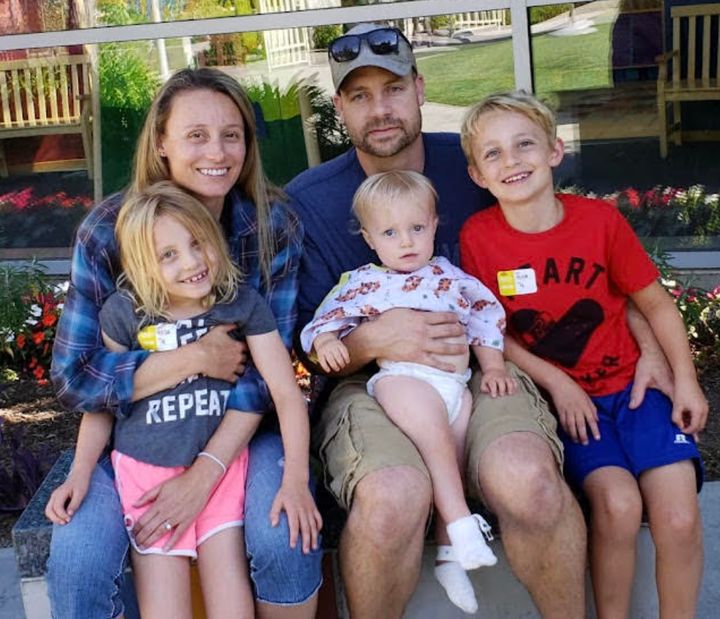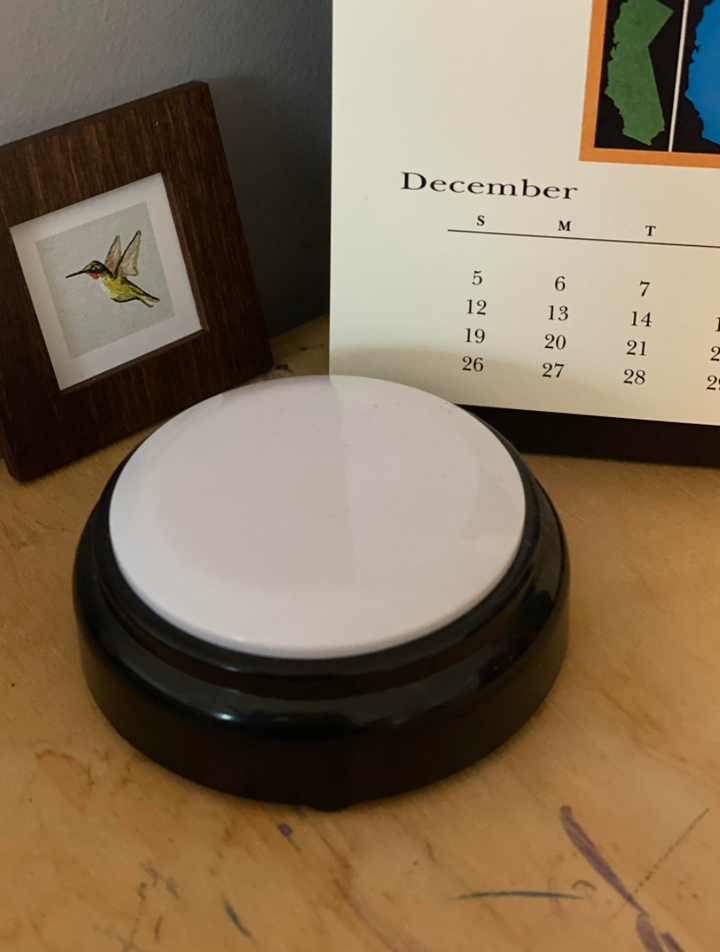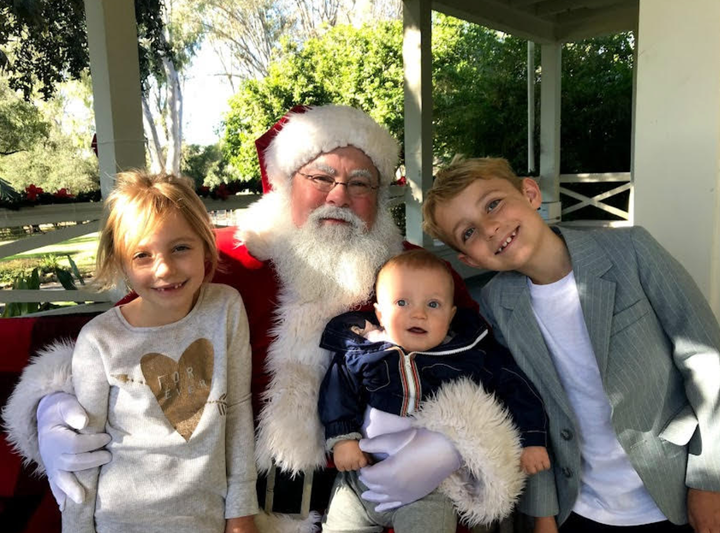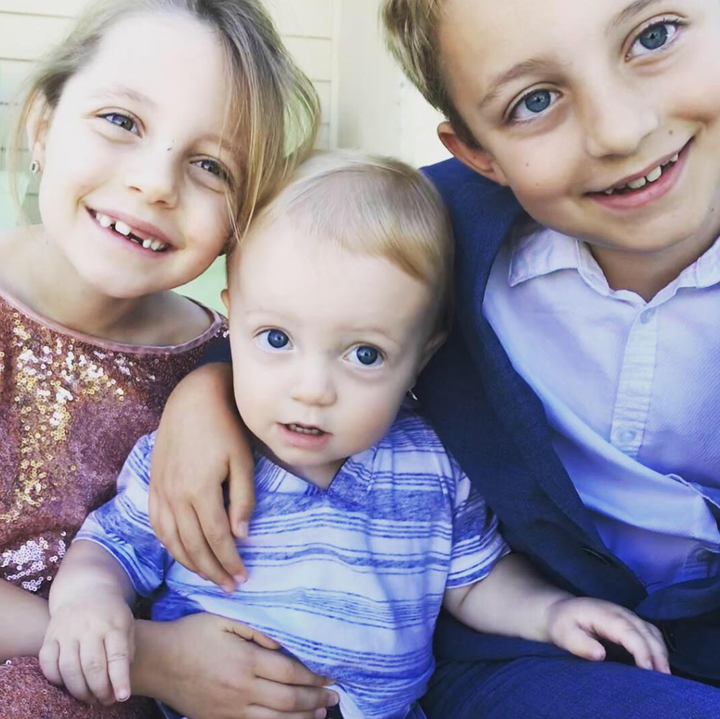
Last Christmas, I sat on the floor surrounded by wrapping paper, new toys and happy kids, then 7 and 9. It was like being in a bubble bath with too much soap ― ribbons and bows flying as each new box was ripped open. It quickly became hard to tell what was a gift and what was trash.
The previous year, our 20-month-old son, Aiden, died unexpectedly during surgery to remove a tumor from his brain. It was our second Christmas without him, and I was still getting used to shopping for two kids instead of three.
“I think it’s Mom’s turn to open her stocking,” my husband, Nick, said.
My daughter brought it over to me, exaggerating her movements as she walked on her knees.
I pulled the first thing out of my stocking — a plastic, round button, like the kind you’d hit if you were on a game show. These are called Easy Buttons.
Usually, they’re bright red with white letters that spell out “Easy.” They became popular in 2005 when Staples began promoting, then selling them. The idea was that you could solve your problem just by hitting this button.
The one in my stocking looked like a knock-off ― it was just plain white with a black base.
I looked up at my husband from the floor with one eyebrow raised in confusion and annoyance.
“Is this for me?” I asked.
“Press it,” he replied.
I hadn’t noticed before, but the kids were watching me closely, waiting for me to press the button too. I pressed it and the room filled with sound.

There were muffled voices, and I wasn’t sure what I was supposed to hear. Then I heard a high-pitched squeal that turned into a laugh. The room blurred, and when I raised my head to look at Nick, gravity took the tears from my eyes and pulled them down my cheeks. It was Aiden playing with his siblings.
In the recording, my daughter says “Hello,” and my older son says “Oh no, oh no,” and then there’s one more loud belly laugh from Aiden. The sound stopped as abruptly as it began, and the room was quiet.
Nick broke the silence. “The recording is 15 seconds, so if you want to change it, you can.”
“It’s perfect,” I said. Nick and the two kids looked proud, and I realized they must have picked out the recording together.
I put the Easy Button on my desk and didn’t think of it much until my best friend Ashley asked me to watch her toddler, Will. She was having another baby and needed someone she trusted to care for him while she recovered in the hospital.
There was never a question as to whether we would take Will. Nick and I are baby people, and toddlers are our specialty. We knew it would be hard, but I thought having a toddler in the house again might be what we needed at this stage in our grief.
“I wasn’t sure if this is something you’d be ready for,” Ashley said.
“We can’t wait,” I told her.
Aiden’s crib was still in our bedroom. We moved it from his room after he got sick, and now it’s been in our room longer than Aiden was alive. The crib had become a shrine overflowing with blankets and stuffed animals and trinkets from his life.
To make room for Will, I piled everything in the crib into a corner, careful not to break the plaster mold of Aiden’s hand or misplace the plastic bag with clippings of his hair.
Then I cleared off my desk. I stacked my books, laptop and favorite pens in the living room. I put the Easy Button on top.

Will is the same age as Aiden was when he was diagnosed with brain cancer. That first night, I listened to Will speak half-words and watched him take half-steps, and for a moment, I couldn’t tell who was who. He was doing all the things Aiden was doing before cancer made his smile crooked and his blond curls fall out.
My daughter was fully prepared to play mom, and almost started crying when I told her she wouldn’t be the one to rock Will to sleep at night. My older son was more reserved. More than once I heard him say “That’s just like Aiden,” his voice trailing off ― maybe lost in the memory? Maybe not wanting to remember fully?
The next day I asked my older son: “How are you feeling about having Will being here? Is it hard for you?”
He paused, considering the question. “No, I mean, it’s hard ― but in a good way.”
I’m embarrassed by the part of me that wanted him to be upset, so we could cry together about how unfair it all is. Instead, my 10-year-old made me feel better about things being sad and feeling joy at the same time.
The next night, Will was crawling around my pile of things in the living room, and he picked up the Easy Button.
I wanted him to press it. This felt like a big moment in our family, and I wanted Aiden to be a part of it.
He pressed it, but instead of letting it play all the way through, he kept pressing and pressing so what came out were stops and starts of Aiden laughing. Nick and I smiled at each other from across the room.

Throughout the week, I prepared bottles and cut chicken nuggets and strawberries into tiny bites. We sang songs and read books, and I remembered what it was like to look forward to nap time.
By the end of the week, we were worn out but satisfied. My friend came to pick up Will, and I witnessed him meeting his baby brother for the first time, and my heart was so full.
We did it. We spent a week with a living, breathing, exhausting, adorable reminder of our grief, and we survived; I’d say we even had fun. But grief is a sneaky fellow.
I had gotten used to seeing bibs, bottles and hooded towels that look like dragons. I fell into the habit of scanning the floor for choking hazards and a crawling baby boy in matching pajamas. And now they were all gone again, and the house was quiet.
It was a familiar feeling. After Aiden died, the older kids returned to school, and Nick returned to work; it was just me and the house. I wandered from room to room, looking for what I knew I wouldn’t find.
Decades before I was born, my mother’s brother died in a tragic accident when he was 4 years old. I remember one sepia-toned picture of him on my grandmother’s dresser. No one ever talked about him, and I got the impression I shouldn’t ask.
My grandparents came of age during the Depression. They’re part of the Greatest Generation, but are also from a time when many people pushed grief into a dark corner and rarely spoke of it.
I, on the other hand, had the instinct to keep my grief front and center. I placed bits and pieces of Aiden everywhere so I only had to turn my head a little to be reminded of him. There were pictures all over the house, a pair of socks in the trunk of my car, and the poster my friend made for his funeral leaning against a wall in the living room.
It was mid-November when Aiden died. The start of the holiday season also marks the start of the mourning season, a time for gathering around a table that will always have one highchair empty, one fewer letter to Santa, one more turn of the New Year without our son.

Our family will never stop grieving, but how that grief expresses itself will change. The things that bring me comfort will evolve.
The crib I wasn’t ready to take down before is now stacked in pieces in the rafters of our garage. I still catch my daughter playing with Aiden’s toys, but I know, eventually, the time will come to donate them.
Next year we are remodeling our house, and I imagine I will have plenty of opportunities to decide what to display, what to pack away, and what to let go ― a sort of Marie Kondo process for grief. Never rushed, never forced, never because it’s something I think I should do.
Before my family gave me that Easy Button, I would have called it a useless gift, but it turned out to be one of my most prized possessions. It brings me comfort. It keeps my grief close, keeps Aiden close as I move through these phases. I use it when I need a smile or a cry or when I want to wallow in anger. It’s a beautiful reminder. It helps me not to forget ― not just Aiden, but the love we all shared. That love hasn’t gone anywhere. I can still feel it. And by celebrating Aiden’s life and remembering the joy he brought us, we keep that love alive.
I press that button to remind myself that what we’ve been through isn’t easy ― but in a good way.
Emily Henderson is a runner and writer living with her husband and three children in Santa Barbara, CA. She writes the Substack, The Bittersweet Weekly and her essays have appeared in Scary Mommy, Writing Class Radio, and The Santa Barbara Independent.
Do you have a compelling personal story you’d like to see published on HuffPost? Find out what we’re looking for here and send us a pitch.
